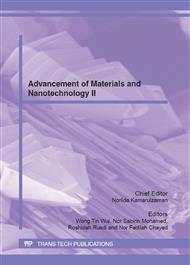p.161
p.165
p.169
p.175
p.182
p.185
p.190
p.195
p.199
Materials Characterization and Charge-Discharge Profile of LiNi1-XCoxO2 Cathodic Materials for Li-Ion Battery Application
Abstract:
Mixed lithium nickel cobalt oxides are advantageous over LiCoO2 due to decrease in cobalt content in the material. It is also better than LiNiO2 which is known to be difficult to synthesize and has poor electrochemical properties. Partial substitution of nickel in lithium nickel oxide with cobalt significantly improves its electrochemical properties. In this work, a combustion method was used for synthesis of LiNi1-xCoxO2 (x= 0.1 and 0.2). The starting materials used are nitrates of the metals or transition metals. The precursors obtained are used for thermal studies. The precursors of LiNi1-xCoxO2 were annealed at a temperature of 700 °C for 24h. X-ray diffraction (XRD) showed that the materials are pure. A composite cathode comprising of the cathode active material, binder and graphite was fabricated. Charge-discharge profiles of the materials with a voltage range of 0.5 V - 4.5 V vs Li/Li+ were obtained in order to study their electrochemical characteristics. The materials exhibited several voltage plateaus attributed to different electrochemical reactions.
Info:
Periodical:
Pages:
182-184
Citation:
Online since:
July 2012
Keywords:
Price:
Сopyright:
© 2012 Trans Tech Publications Ltd. All Rights Reserved
Share:
Citation:


